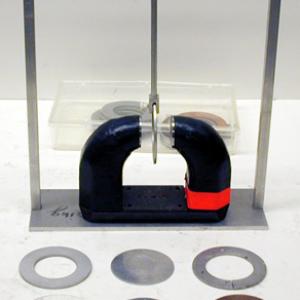College of Liberal Arts & Sciences
5K20.10 - Magnetic and Electromagnetic Damping
Set up the permanent magnet demo as shown. Attach an unbroken ring or disk to the pendulum and observe the damping. Replace with a broken ring, slotted plate, or nonmagnetic material and observe no damping of the pendulum.
Take the long flat piece of aluminum and move it back and forth between the poles of the magnet and feel the damping force.
The electromagnetic damping is arranged as shown. The pendulum pivot may need to be oiled. Turn on the circuit breaker of the power supply.
NOTE: The power supply should already be pre-set at approximately 35 AC volts, or 50 DC volts on the output.
Start the pendulum swinging. As the pendulum swings between the poles of the electromagnet turn on the switch and the magnet will have built up enough of a magnetic field to stop the pendulum as it comes back between the poles again. PRACTICE is needed to get the timing down.
- Carlos Saraiva, "Demonstrating Lenz's Law with Recycled Materials", TPT, Vol. 44, #3, Mar. 2006, p. 182.
- C. L. Hamilton, J. H. Hamilton, D. A. Burba, and E. A. Jones, "Some Electrical Demonstrations Using a Strong Permanent Magnet, TPT, #4, Apr. 1987, p. 223.
- Andris Muiznieks, Inese Dudareva, "Quantitative Analysis of the Damping of Magnet Oscillations by Eddy Currents in Aluminum Foil", AJP, Vol. 80, #9, Sep. 2012, p. 804.
- Thomas B. Greenslade Jr., "Eddy Current Pendulum (Photo)", AJP, Vol. 71, #7, July 2003, p. 660.
- Louis H. Cadwell, "Magnetic Damping: Analysis of an Eddy Current Brake Using an Airtrack", AJP, Vol. 64, #7, July 1996, p. 917.
- W. M. Saslow, "Maxwell's Theory of Eddy Currents in Thin Conducting Sheets, and Applications to Electromagnetic Shielding and MAGLEV", AJP, Vol. 60, #8, Aug. 1992, p. 693.
- Mark A. Heald, "Magnetic Braking: Improved Theory", AJP, Vol. 56, #6, June 1988, p. 521.
- H. D. Wiederick, et al., "Magnetic Braking: Simple Theory and Experiment", AJP, Vol. 55, #6, June 1987, p. 500.
- Tim Herrernan, "The 121-Story Tower that Never Sways", Popular Mechanics, April 2015, p. 17.
- "B-285. Magnetic Braking with Disk", DICK and RAE Physics Demo Notebook.
- El-2, 3, 4, 6: Freier and Anderson, A Demonstration Handbook for Physics.
- El-2, 3, 4, 6: Freier and Anderson, A Demonstration Handbook for Physics.
- El-2, 3, 4, 6: Freier and Anderson, A Demonstration Handbook for Physics.
- El-2, 3, 4, 6: Freier and Anderson, A Demonstration Handbook for Physics.
- George M. Hopkins, "Dynamic Electricity", Experimental Science, p. 463.
- Yaakov Kraftmakher, "2.2. Pendulum", Experiments and Demonstrations in Physics, ISBN 981-256-602-3, p. 84.
- Raymond Bruman, "Eddy Currents", Exploratorium Cookbook I, p. 82.1 - 82.2.
- Robert Ehrlich, "N.4. Magnet Pendulum Swinging Over a Copper Sheet", Turning the World Inside Out and 174 Other Simple Physics Demonstrations, p. 166 - 167.
Disclaimer: These demonstrations are provided only for illustrative use by persons affiliated with The University of Iowa and only under the direction of a trained instructor or physicist. The University of Iowa is not responsible for demonstrations performed by those using their own equipment or who choose to use this reference material for their own purpose. The demonstrations included here are within the public domain and can be found in materials contained in libraries, bookstores, and through electronic sources. Performing all or any portion of any of these demonstrations, with or without revisions not depicted here entails inherent risks. These risks include, without limitation, bodily injury (and possibly death), including risks to health that may be temporary or permanent and that may exacerbate a pre-existing medical condition; and property loss or damage. Anyone performing any part of these demonstrations, even with revisions, knowingly and voluntarily assumes all risks associated with them.
